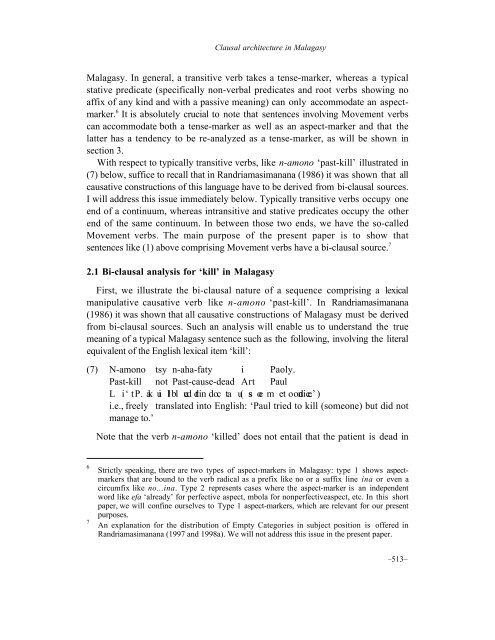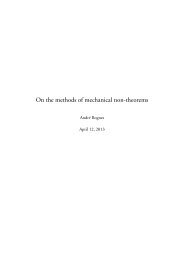Clausal architecture and movement verbs in Malagasy
Clausal architecture and movement verbs in Malagasy
Clausal architecture and movement verbs in Malagasy
You also want an ePaper? Increase the reach of your titles
YUMPU automatically turns print PDFs into web optimized ePapers that Google loves.
<strong>Clausal</strong> <strong>architecture</strong> <strong>in</strong> <strong>Malagasy</strong><br />
<strong>Malagasy</strong>. In general, a transitive verb takes a tense-marker, whereas a typical<br />
stative predicate (specifically non-verbal predicates <strong>and</strong> root <strong>verbs</strong> show<strong>in</strong>g no<br />
affix of any k<strong>in</strong>d <strong>and</strong> with a passive mean<strong>in</strong>g) can only accommodate an aspectmarker.<br />
6 It is absolutely crucial to note that sentences <strong>in</strong>volv<strong>in</strong>g Movement <strong>verbs</strong><br />
can accommodate both a tense-marker as well as an aspect-marker <strong>and</strong> that the<br />
latter has a tendency to be re-analyzed as a tense-marker, as will be shown <strong>in</strong><br />
section 3.<br />
With respect to typically transitive <strong>verbs</strong>, like n-amono ‘past-kill’ illustrated <strong>in</strong><br />
(7) below, suffice to recall that <strong>in</strong> R<strong>and</strong>riamasimanana (1986) it was shown that all<br />
causative constructions of this language have to be derived from bi-clausal sources.<br />
I will address this issue immediately below. Typically transitive <strong>verbs</strong> occupy one<br />
end of a cont<strong>in</strong>uum, whereas <strong>in</strong>transitive <strong>and</strong> stative predicates occupy the other<br />
end of the same cont<strong>in</strong>uum. In between those two ends, we have the so-called<br />
Movement <strong>verbs</strong>. The ma<strong>in</strong> purpose of the present paper is to show that<br />
sentences like (1) above compris<strong>in</strong>g Movement <strong>verbs</strong> have a bi-clausal source. 7<br />
2.1 Bi-clausal analysis for ‘kill’ <strong>in</strong> <strong>Malagasy</strong><br />
First, we illustrate the bi-clausal nature of a sequence compris<strong>in</strong>g a lexical<br />
manipulative causative verb like n-amono ‘past-kill’. In R<strong>and</strong>riamasimanana<br />
(1986) it was shown that all causative constructions of <strong>Malagasy</strong> must be derived<br />
from bi-clausal sources. Such an analysis will enable us to underst<strong>and</strong> the true<br />
mean<strong>in</strong>g of a typical <strong>Malagasy</strong> sentence such as the follow<strong>in</strong>g, <strong>in</strong>volv<strong>in</strong>g the literal<br />
equivalent of the English lexical item ‘kill’:<br />
(7) N-amono tsy n-aha-faty i Paoly.<br />
Past-kill not Past-cause-dead Art Paul<br />
L i‘ t P. ak ui l bl uedd t <strong>in</strong>d oc t a u( s oe m et oo ndie.’ e )<br />
i.e., freely translated <strong>in</strong>to English: ‘Paul tried to kill (someone) but did not<br />
manage to.’<br />
Note that the verb n-amono ‘killed’ does not entail that the patient is dead <strong>in</strong><br />
6 Strictly speak<strong>in</strong>g, there are two types of aspect-markers <strong>in</strong> <strong>Malagasy</strong>: type 1 shows aspectmarkers<br />
that are bound to the verb radical as a prefix like no or a suffix l<strong>in</strong>e <strong>in</strong>a or even a<br />
circumfix like no...<strong>in</strong>a. Type 2 represents cases where the aspect-marker is an <strong>in</strong>dependent<br />
word like efa ‘already’ for perfective aspect, mbola for nonperfectiveaspect, etc. In this short<br />
paper, we will conf<strong>in</strong>e ourselves to Type 1 aspect-markers, which are relevant for our present<br />
purposes.<br />
7 An explanation for the distribution of Empty Categories <strong>in</strong> subject position is offered <strong>in</strong><br />
R<strong>and</strong>riamasimanana (1997 <strong>and</strong> 1998a). We will not address this issue <strong>in</strong> the present paper.<br />
–513–

















